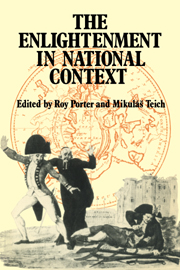Book contents
- Frontmatter
- Contents
- Preface
- 1 The Enlightenment in England
- 2 The Scottish Enlightenment
- 3 The Enlightenment in France
- 4 The Enlightenment in the Netherlands
- 5 The Enlightenment in Switzerland
- 6 The Italian Enlightenment
- 7 The Protestant Enlightenment in Germany
- 8 The Enlightenment in Catholic Germany
- 9 Reform Catholicism and Political Radicalism in the Austrian Enlightenment
- 10 Bohemia: From Darkness into Light
- 11 The Enlightenment in Sweden
- 12 The Russian Enlightenment
- 13 Enlightenment and the Politics of American Nature
- Afterword
- Notes to the text
- Further reading
- Index
11 - The Enlightenment in Sweden
Published online by Cambridge University Press: 24 September 2009
- Frontmatter
- Contents
- Preface
- 1 The Enlightenment in England
- 2 The Scottish Enlightenment
- 3 The Enlightenment in France
- 4 The Enlightenment in the Netherlands
- 5 The Enlightenment in Switzerland
- 6 The Italian Enlightenment
- 7 The Protestant Enlightenment in Germany
- 8 The Enlightenment in Catholic Germany
- 9 Reform Catholicism and Political Radicalism in the Austrian Enlightenment
- 10 Bohemia: From Darkness into Light
- 11 The Enlightenment in Sweden
- 12 The Russian Enlightenment
- 13 Enlightenment and the Politics of American Nature
- Afterword
- Notes to the text
- Further reading
- Index
Summary
In Sweden the Enlightenment never formed a truly coherent current of ideas or became a unified movement. And by the time it finally appeared in an assertive, propagandist form which might have borne comparison with the French models, the end of the century had arrived and we were on the threshold of a new era, Romanticism. Sweden thus had no Voltaire, no Hume, hardly even its Rousseau. But obviously there were sporadic elements of Enlightenment ideas, and French and English writers of the period were known – and contradicted and opposed – at an early date.
The explanation for this is to be sought in the political and social background and in the resulting intellectual climate. Ideas never arise in a vacuum; there has to be the right soil for their germination and growth. Quite simply, they must have an application – it must be possible to assign them a function.
THE POLITICAL AND ECONOMIC SITUATION
The long war waged by Charles XII had brought economic ruin to Sweden. His death in 1718 marked the advent of a new era, known as the Age of Freedom. This name refers to liberty from absolutism. The Swedish riksdag had seen the consequences of an autocratic king deciding everything. The time for that way had now passed; the estates were to rule and the king would be only formally the head of the realm.
- Type
- Chapter
- Information
- The Enlightenment in National Context , pp. 164 - 175Publisher: Cambridge University PressPrint publication year: 1981
- 2
- Cited by



